Bulletin – July 2007 Loan Approvals, Repayments and Housing Credit Growth[1]
- Download 118KB
Introduction
The majority of household borrowing is for the purchase of existing or new housing. Developments in borrowing for housing are important for several reasons. Some of this borrowing is for home building, which is an important component of real economic activity. More broadly, understanding developments in borrowing for housing helps in assessing economic conditions in the household sector, and in identifying risks associated with household finances and the overall health of the financial system.
Since late 2003, growth in housing credit has slowed from above 20 per cent to around 13 per cent as policy rates have risen and growth in house prices has slowed. This article examines how changing household borrowing and repayment behaviour has contributed to the slowing in the rate of growth in housing credit over this period.
Recent Developments in Housing Credit Growth
There are two main indicators of borrowing for housing that are closely watched by market participants and policy-makers – new housing loan approvals and housing credit growth (i.e. the change in the outstanding balance on home loans). These series tend to move fairly closely together, since housing loan approvals are an important driver of housing credit growth. Graph 1 shows monthly growth in housing credit in recent years, as well as the value of new housing loans approved as a share of outstanding credit each month, which represents the percentage point contribution of these new loans to housing credit growth.[2] Housing credit does not typically increase by the full amount of new loans because existing loans are also being repaid over time.[3] Changes in housing credit also tend to lag new loan approvals, with the lag between when a loan is approved and when it is drawn down typically one to two months due to the settlement period on property sales. Both the rate of new loan approvals and housing credit growth have slowed since late 2003. However, the growth in housing credit does not always move in lockstep with loan approvals, as can be seen by the fluctuations in the difference between the two series shown in the bottom panel of Graph 1. This suggests that movements in net repayments have also had a significant influence on the growth of credit outstanding over this period.
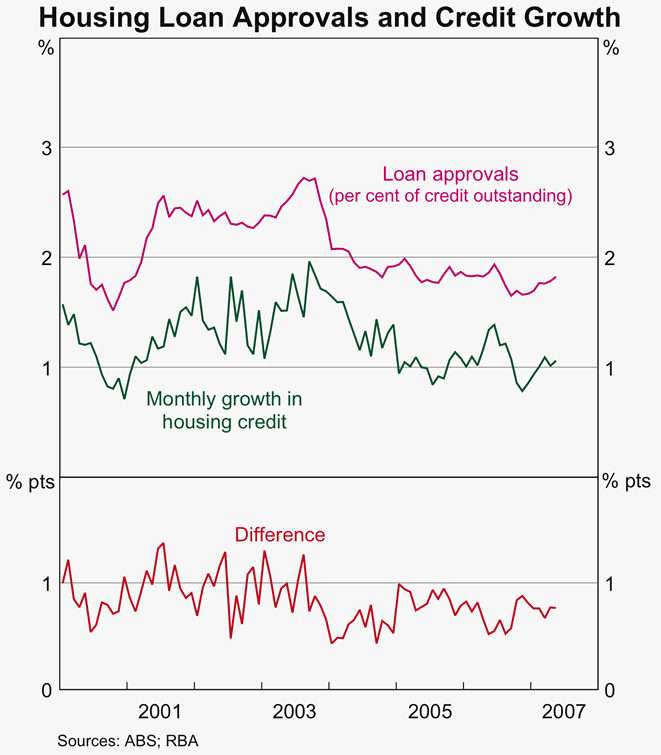
Determinants of Housing Credit Growth
Housing credit growth is influenced both by the rate at which households borrow money for housing and the rate at which they repay outstanding housing loans. Specifically, the change in housing credit is equal to the amount of new loans extended less the amount of net principal repayments on existing loans (Box A). Net principal repayments are equal to total principal repayments less redraws from existing loans (which generally occur when borrowers who are ahead of schedule on their loan repayments withdraw excess principal already paid) and increases in borrowing through refinancing of existing loans and line of credit drawdowns.[4] Total principal repayments can be separated into three different components: scheduled principal repayments, which along with interest make up the regular payments required to service a loan; repayments of principal in excess of this required amount; and full repayment of the outstanding loan balance. These different borrowing and repayment behaviours are examined in more detail below.
| where net principal repayments = | + scheduled principal repayments |
|---|---|
| + excess principal repayments | |
| + full loan repayments | |
| – redraws | |
| – increases in borrowing through refinancing and lines of credit |
New loans
The most significant driver of credit growth is the extension of new loans, which are measured using new housing loan approvals. The rate at which households have taken out new housing loans has slowed noticeably since 2003, as shown by the reduction in loan approvals relative to outstanding housing credit in Graph 1. The increase in interest rates over this period – actual variable mortgage interest rates (i.e. after discounting) have risen by around 180 basis points since mid 2002 – has contributed to the slowing in growth of new loan approvals by making borrowing more expensive (Graph 2). Higher interest rates would seem to have played some part in the slower house price growth since 2003, which has flowed through to the average size of loans approved (Graph 3). Moreover, there has been slower growth in the number of new loans as higher interest rates and slower house price growth have discouraged some households from borrowing for housing. This has been particularly evident in the investor market, which has also been affected by low rental yields. In contrast, the slower pace of housing price increases has helped first-home buyers to enter the housing market; the share of owner-occupier housing loan approvals going to first-home buyers declined to around 18 per cent in early 2004, but has since increased to be back around its long-run average share of around 25 per cent.
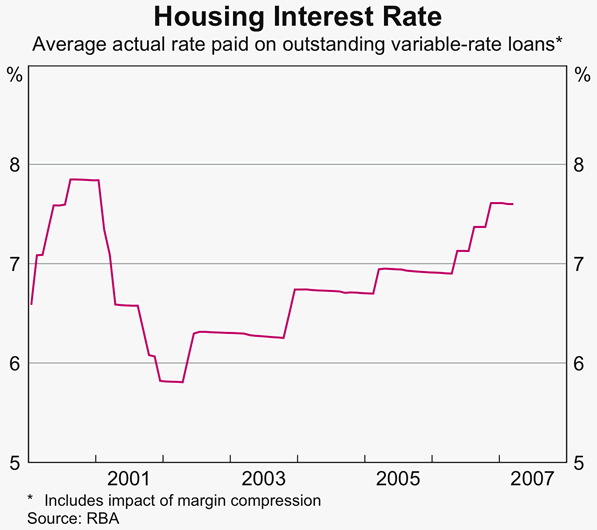
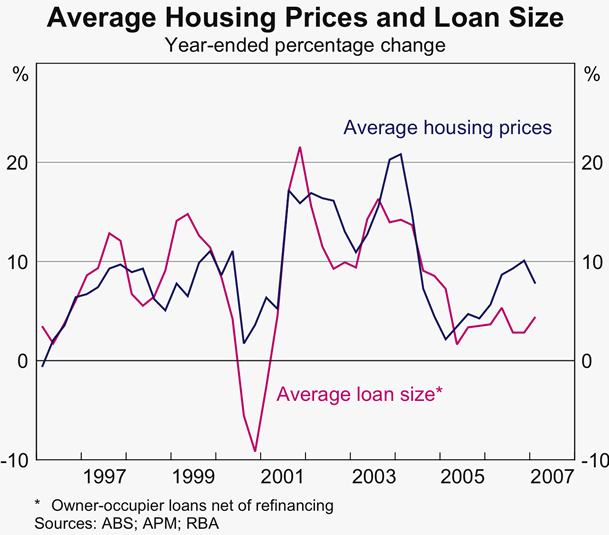
Net principal repayments
The less pronounced slowing in housing credit growth than is suggested by new loan approvals indicates that net principal repayments relative to outstanding debt have been lower in recent years than previously. Since 2004, net monthly principal repayments have averaged around ¾ per cent of outstanding credit, compared with around 1 per cent in previous years (Graph 1). Considering each of the components of net principal repayments, there are several reasons why this may have occurred.
Scheduled principal repayments
There are a number of changes in the characteristics of housing loans that together suggest the rate of scheduled principal repayments may be lower on average than was previously the case. For traditional variable-interest-rate loans, the rise in interest rates since 2002 will have increased total mortgage payments but lowered the amount of the current scheduled principal repayment.[5] The increased availability and use of interest-only loans – whereby principal is not required to be repaid during the first part of the loan, which can be for up to 10–15 years – is another reason why home loans on average are being repaid more slowly. Interest-only loans have grown from a low level earlier this decade to account for around one-third of the value of housing loan approvals in 2005 and a slightly lower share of total outstanding housing credit.[6] Finally, the trend towards longer remaining mortgage terms is likely to have reduced loan repayment rates, since principal repayments are spread over a longer time period. The increase in remaining loan terms has been driven by two factors. First, the length of new loans has been increasing over recent years, with 30-year terms becoming more common. Second, mortgagees on average are likely to be closer to the start of their loan given the large amount of turnover in properties and refinancing of loans during the housing boom.
Excess principal repayments
Households may also make extra loan repayments in addition to scheduled loan repayments. While penalty fees for early repayment of principal are often charged on fixed-rate loans and during honeymoon or introductory rate periods on loans, variable-rate loans typically allow borrowers to make excess repayments of principal without penalty. Although there are no precise data on the extent of excess principal repayments, information in the Household, Income and Labour Dynamics in Australia (HILDA) Survey suggests that around one-half of owner-occupier borrowers had made excess principal repayments and so were ahead of schedule in their mortgage repayments in 2005. More recent liaison with banks indicates that roughly one-quarter of owner-occupier borrowers are more than a year ahead on their mortgage repayments and around one-half are more than one month ahead.
Excess principal repayments may reflect deliberate efforts by households to pay down their mortgages more quickly than required. This is increasingly likely as interest rates rise, since the higher cost of borrowing will encourage borrowers to repay loans more quickly if they are able. However, it should be noted that higher interest costs may also reduce the capacity of some borrowers to make excess principal repayments. Borrowers' decisions to make excess principal repayments may also be affected by factors other than interest rates, including income growth and expectations of economic security. Expectations of returns on other assets could also be relevant, since borrowers may be attracted to invest money in other strongly performing assets rather than making additional loan repayments.
Excess principal repayments may also change passively if borrowers do not adjust the amount of their regular loan payments when interest rates, and accordingly required payments, change. When interest rates fall, as occurred in 2001 when the cash rate was lowered by 200 basis points, if borrowers do not reduce their regular loan payments in line with required payments their excess principal repayments will increase. Conversely, as mortgage rates rise, some borrowers may make smaller excess principal repayments if they do not increase their total loan payments, since at least part of their excess principal repayment will be absorbed by higher interest payments. Such passive adjustment of excess principal repayments appears relatively common; according to the HILDA Survey, around 30 per cent of households with housing loans maintain constant loan repayments from year to year despite interest rate changes. Hence the 200 basis point increase in the cash rate since mid 2002 is likely to have lowered excess repayments for some households and this may have contributed to the strength in credit growth relative to loan approvals in recent years.
Full repayments
The size of full repayments of loans also influences credit growth. The early full repayment of a loan often occurs on the sale of the property. When a property is sold, the loan taken out by the purchaser will typically be larger than the seller's outstanding loan on that property. Thus, the net effect of that transaction is usually to increase borrowing by the difference between the amount the buyer borrows and the outstanding balance on the seller's loan. This net effect on borrowing will be greater when property prices have been increasing rapidly, since the seller is likely to have taken out a relatively smaller loan when they originally purchased the property than the buyer now needs. This will reduce the size of full loan repayments relative to loan approvals, resulting in relatively more of each loan approval flowing through to credit growth. The doubling in housing prices over the seven years to 2003 could thus help to explain why housing credit growth has not declined by the same extent as the rate of loan approvals over recent years.
Redraws and refinancing of existing loans
Redraws on existing loans add to credit growth. Where a borrower is ahead of schedule on their principal repayments, their loan may allow them to withdraw the excess principal paid. Other ways households can effectively redraw from existing housing loans are to refinance them for a larger amount or draw down a line of credit.
There are a number of factors which are likely to have influenced redraws on existing loans in recent years. First, loans with offset accounts and home-equity loans have become increasingly available over the past decade, increasing the ease of redrawing because they effectively provide transaction accounts from which any withdrawal is a redraw on the loan.[7] Second, the very strong growth in housing prices since the mid 1990s, by increasing households' net worth, is likely to have made them feel more comfortable drawing down on excess principal paid. Of course, interest rates are another factor that influences redraws on existing loans – the increase in interest rates since mid 2002, by raising the cost of borrowing, is likely to have discouraged redraws, offsetting some of the above effects.
In regard to refinancing, the strong gains in property prices are likely to have made it possible for increasing numbers of households to refinance their housing loans for larger amounts. In addition, with the increased competition in the home lending market reducing interest rate margins since the mid 1990s, refinancing has become more frequent as borrowers have increasingly found lenders offering lower interest rates. In this environment, refinancing for larger amounts is also likely to be more common.
The value of loan approvals for refinancing increased strongly from 2000 to 2003 and remains at a high level, suggesting these and redraws on existing loans are greater than they were at the start of the decade (Graph 4).[8] While not all loans are refinanced for a larger amount, available data suggest additional credit obtained when refinancing is substantial. Of those loans identified as having been refinanced by the RBA's Survey of Housing Equity Withdrawal and Injection in 2004, around 90 per cent increased in size. The median increase on such loans was 26 per cent. More recently, data obtained from some state governments indicate that borrowers refinancing their home loans for larger amounts in 2006 increased their loan sizes substantially on average, by somewhere between one-quarter and one-half.
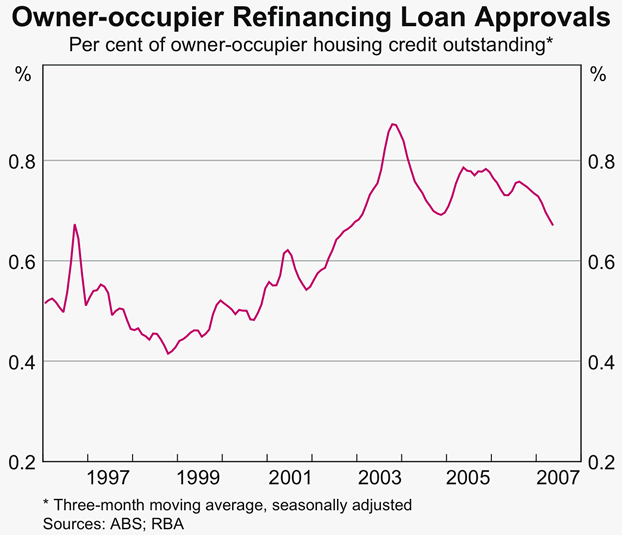
Some Evidence on Excess Principal Repayments and Redraws
While precise data on the different borrowing and repayment behaviours discussed above are not available, an estimate of net excess principal repayments (i.e. incorporating the effect of redraws of excess principal previously paid) can be derived from data on a sample of home loans. This series provides an indication of how net excess principal repayments may have changed over time.[9] An estimate of the monthly net excess principal repayment can be calculated as the difference between the required principal repayment and the actual change in the outstanding balance of each loan.[10] While information from a sample of loans will not perfectly reflect borrowers' aggregate actual excess repayments and redraws, it should at least provide some indication of how they may have changed over time.
Graph 5 shows that while estimated net excess principal repayments are fairly volatile, they appear to have fallen over recent years in the loan sample surveyed. Between 2000 and early 2002, net excess repayments averaged around ½ per cent of outstanding loan balances per month. Since mid 2002, however, excess repayments less redraws appear to have fallen, and averaged around ¼ per cent of outstanding loan balances per month over most of 2004 to 2006, implying only ¼ percentage point subtraction from housing credit growth.
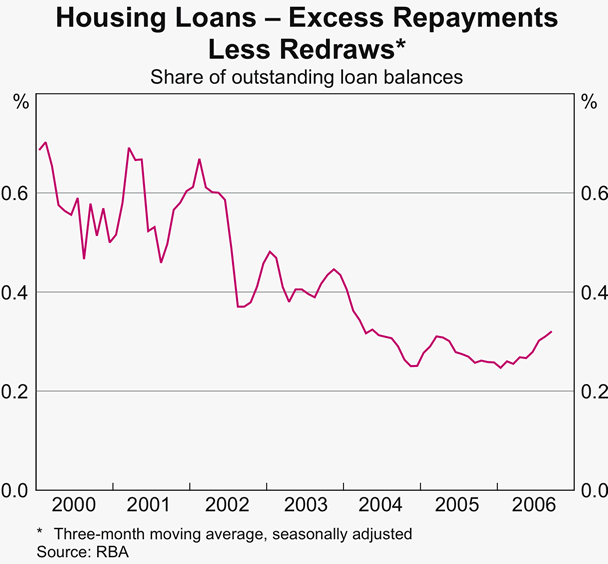
As discussed above, there are a range of factors that affect excess principal repayments and redraws. It is likely that reduced excess principal repayments are at least in part related to the increase in interest rates since mid 2002, as borrowers' capacity to make excess principal repayments is reduced by higher interest costs. Similarly, some borrowers' excess repayments are likely to have been passively reduced, since they will not have increased their regular loan payments in line with interest rates. The reduction in net principal repayments may also reflect an increase in redraws on loans both reflecting the greater availability of such facilities and the sharp increase in housing prices since the mid 1990s. However, the degree of net excess repayments appears to have stabilised over the past couple of years, perhaps reflecting a desire by some borrowers to repay loans more quickly following increases in interest rates, slower house price growth and robust real income growth.
Conclusion
The slowing in housing credit growth over recent years is broadly consistent with the slowing in the rate of new borrowing for housing, as indicated by new housing loan approvals. However, growth in housing credit does not appear to have slowed by as much as new loan approvals, which suggests that net repayments of existing housing loans have also slowed. This article has discussed a range of factors that influence borrowing and repayment behaviour, a number of which can help explain the reduction in net repayments of existing loans. However, there are not sufficient data on households' borrowing and repayment behaviour to draw strong conclusions about the relative importance of changes in the different components of net housing loan repayments and thus the various factors likely to be driving them. While it is clear that interest rates have a significant impact on the new borrowing decision, their effects on loan repayments are more complex. Nevertheless, current evidence suggests that some of the effect of the rise in interest rates on new lending has been offset by a reduction in excess repayments on existing loans over recent years, with the result that the decline in credit growth has been a little smaller than the decline in loan approvals.
Footnotes
This article was prepared by Andrea Brischetto and Tom Rosewall of Economic Analysis Department. [1]
New loan approvals are calculated from the ABS Housing Finance release (Cat No 5609.0) as the sum of: owner-occupier loan approvals for construction, purchase of new dwellings, purchase of established dwellings and secured alterations & additions (net of refinancing and cancellations); and investor loan approvals (net of loans for construction and loans to ‘others’, both of which are likely to be to businesses). [2]
Further, some new loans are not drawn down, though we take this into account by calculating approvals net of cancellations. [3]
A loan is ‘refinanced’ when a loan on a property is replaced either with a loan from the same institution or from another institution. [4]
This is a feature of our assumed repayment calculation method, the credit-foncier method. [5]
Unsurprisingly, interest-only loans are more common among investors, as interest is tax deductible on investor housing loans but not on owner-occupier loans. Surveys and securitisation data suggest that around 60 per cent of new investor housing loans in 2005 were interest-only, compared with around 15 per cent of new owner-occupier loans. [6]
The effect of movements in offset accounts on credit growth depends on whether institutions report loans net or gross of these accounts. [7]
This series will not represent the total effect of refinancing on credit growth. On the one hand, this understates the true extent of refinancing, since loans refinanced with the same lender do not require a loan approval as measured by the ABS. On the other hand, these approvals measure the total size of refinanced loans rather than the change in loan size with refinancing, which is what is relevant for credit growth. [8]
Estimates are based on a sample of securitised loans. [9]
Required loan repayments for these loans can be estimated using information on outstanding home loan balances, interest rates being charged, the remaining terms of loans and loan types. These are calculated monthly such that maintaining this payment over time would result in the loan being paid off at the originally agreed end date. The difference between the required principal repayment and the actual change in the outstanding balance of each loan can then be interpreted as the monthly excess principal repayment less redraws of excess principal previously paid. While lenders calculate payments at different times using different methods, this will approximate excess repayments on average. [10]